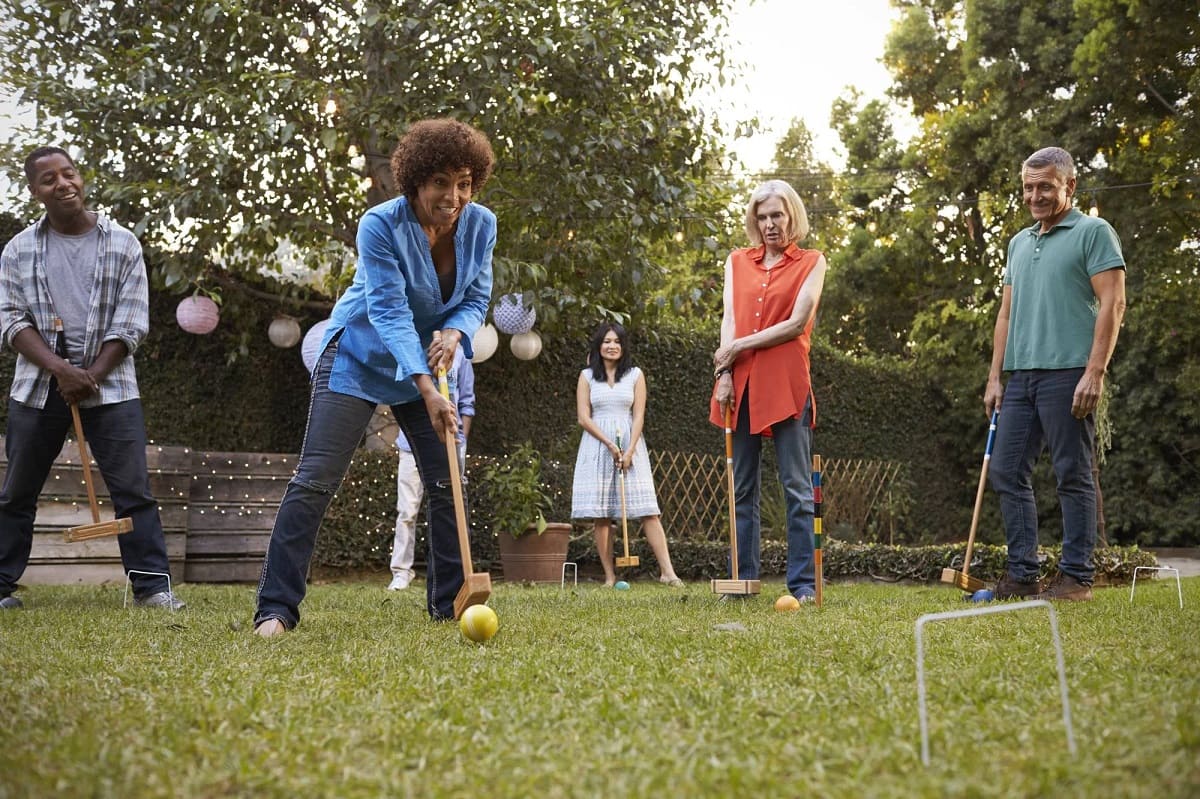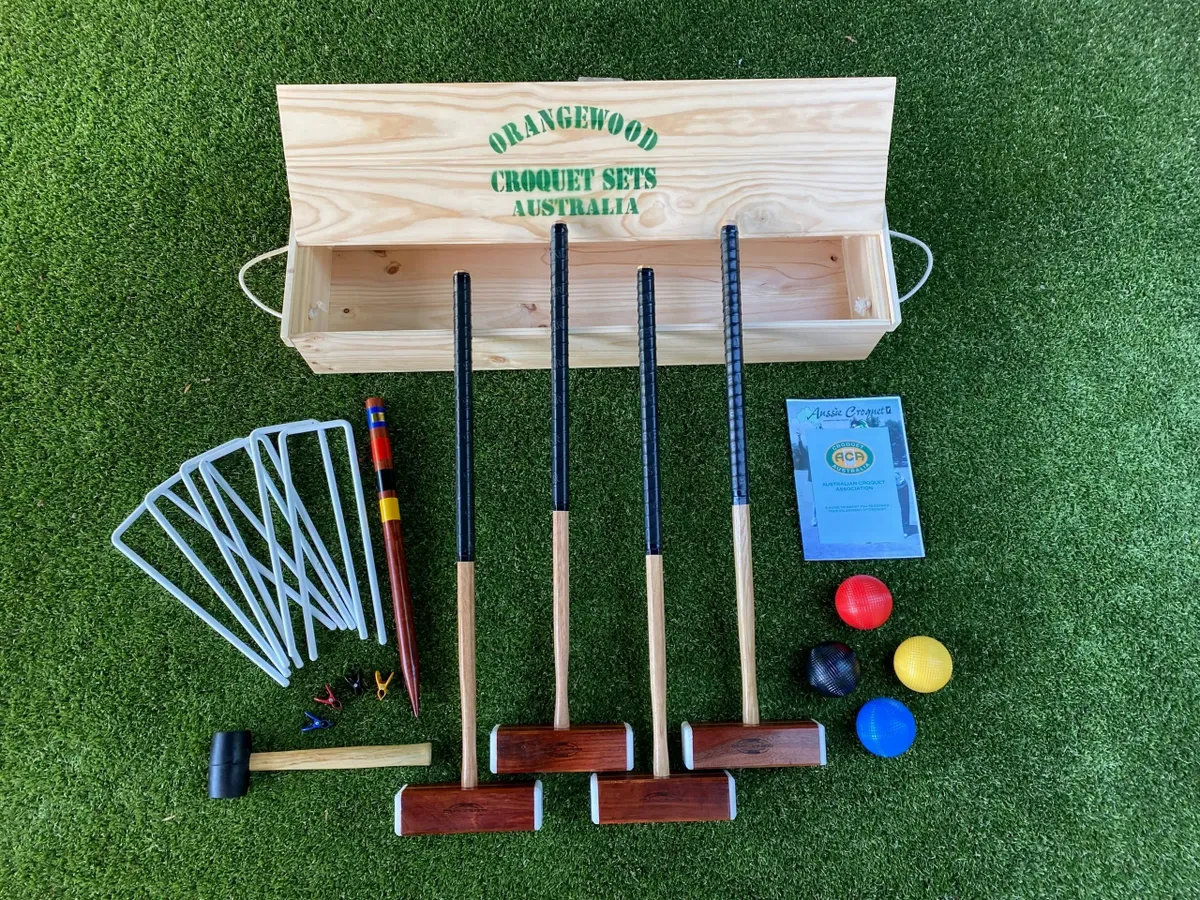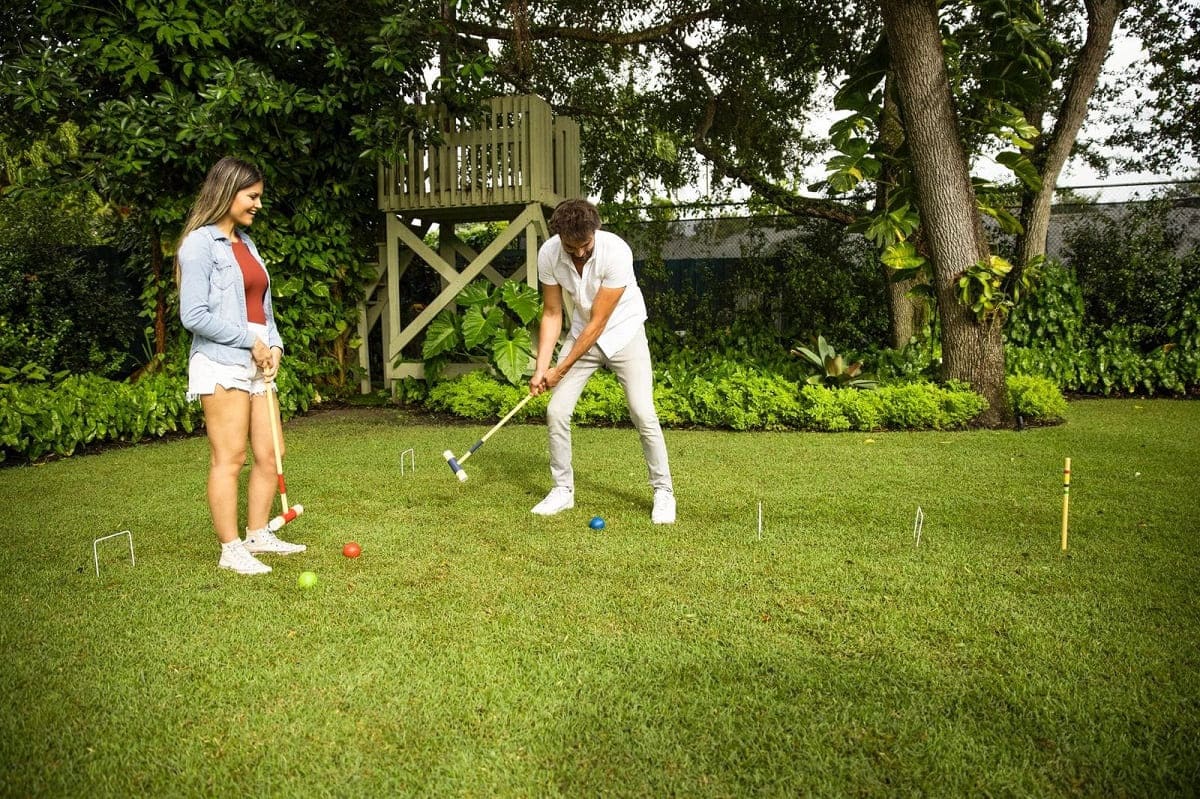Home>Gardening & Outdoor>Outdoor Recreation & Activities>What Is Croquet? (The Game)


Outdoor Recreation & Activities
What Is Croquet? (The Game)
Modified: April 21, 2024
Discover the rules, equipment, and strategies of croquet, a classic outdoor recreation and activity. Learn how to play and enjoy this timeless game.
(Many of the links in this article redirect to a specific reviewed product. Your purchase of these products through affiliate links helps to generate commission for Storables.com, at no extra cost. Learn more)
History of Croquet
Croquet, a beloved outdoor game enjoyed by people of all ages, has a rich and fascinating history that dates back to the 19th century. Its origins can be traced to the verdant lawns of Ireland and France, where it was initially known as "paille-maille" and "pall-mall," respectively. The game gained popularity in England during the 1850s, eventually spreading to other parts of the world.
The modern version of croquet as we know it today emerged in the mid-19th century in Ireland, where it was played with hoops, mallets, and balls on carefully manicured lawns. The game's popularity quickly soared, and it became a favorite pastime among the British upper class. In 1868, the All England Croquet Club was established, and the sport's formalized rules were developed, leading to the standardization of the game.
During the Victorian era, croquet became a fashionable and social activity, with elaborate lawn parties and tournaments being organized. The game's appeal extended beyond the aristocracy, as it offered a delightful way for people to socialize and enjoy the outdoors. As croquet continued to gain momentum, it crossed the Atlantic and found enthusiastic enthusiasts in the United States, where it became a cherished leisure pursuit.
In the 20th century, croquet evolved further, with various regional and international associations being formed to govern the sport and organize competitive events. The World Croquet Federation, established in 1984, has played a pivotal role in promoting the game on a global scale, fostering camaraderie among players from diverse backgrounds.
Today, croquet remains a beloved pastime, cherished for its blend of strategy, skill, and sociability. Its enduring legacy is a testament to the timeless appeal of this delightful outdoor game, which continues to captivate players and spectators alike with its rich history and engaging gameplay.
Key Takeaways:
- Croquet is a classic outdoor game with a rich history dating back to the 19th century, offering a delightful blend of strategy, skill, and sociability for players of all ages.
- Playing croquet provides social interaction, physical activity, and mental stimulation, making it a cherished pastime that transcends generations and fosters inclusive recreation.
Read more: What Are The Rules Of Croquet?
Rules and Objectives of the Game
Croquet is a captivating game that combines elements of strategy, precision, and finesse. The primary objective of the game is to guide your ball through a series of hoops, known as wickets, in a specific sequence and direction, ultimately aiming to strike the finishing stake before your opponents. As players take turns maneuvering their balls across the playing field, strategic positioning and tactical shot-making become paramount. To ensure fair play and an enjoyable experience for all participants, croquet is governed by a set of rules that define the gameplay and conduct.
Gameplay Basics
The game typically involves two opposing players or teams, each aiming to navigate their colored balls (blue, red, black, and yellow) through the course. The sequence of play is determined by the color of the balls, with blue and black competing against red and yellow. The order of turns is established at the beginning of the game and remains consistent throughout.
Hoops and Stakes
The playing field is adorned with six hoops and a finishing stake, strategically positioned to create an engaging and challenging course. The primary objective is to guide your ball through the hoops in a specific order, earning points for each successful passage. Once a ball has traversed all the hoops, the player must strike the finishing stake to secure victory.
Shots and Turns
Players take turns striking their balls with a mallet, aiming to navigate through the hoops while strategically positioning their opponents' balls for tactical advantage. A successful shot requires precision and careful consideration of the ball's trajectory, as well as the strategic placement of the opponent's balls to impede their progress.
Read more: What Is A Croquet Field Called?
Fouls and Penalties
To maintain fairness and sportsmanship, croquet has established rules governing fouls and penalties. These include striking the wrong ball, failing to pass through a hoop, or making an illegal shot. Penalties may result in the opponent gaining additional shots or the offending player's ball being moved to a designated location.
Winning the Game
The game concludes when a player successfully navigates their ball through all the hoops and strikes the finishing stake in the correct order. This achievement, known as "pegging out," secures victory for the player or team, marking the culmination of strategic maneuvering and skillful play.
In essence, croquet offers a delightful blend of strategy, skill, and camaraderie, making it a cherished outdoor activity for players of all ages. The game's rules and objectives provide a framework for engaging gameplay, fostering a sense of friendly competition and sportsmanship among participants. Whether played casually in a backyard setting or in organized tournaments, croquet continues to captivate enthusiasts with its timeless appeal and engaging dynamics.
Equipment Needed for Croquet
When preparing for a delightful game of croquet, it's essential to gather the necessary equipment to ensure a seamless and enjoyable experience. The game of croquet requires a specific set of items that contribute to its engaging dynamics and strategic gameplay. Here's a detailed look at the essential equipment needed for croquet:
1. Mallets
The mallet serves as the primary tool for striking the balls and maneuvering them across the playing field. Typically made of hardwood, the mallet features a sturdy handle and a weighted head, allowing players to exert precise control over their shots. Each player or team requires a set of mallets, with distinct colors corresponding to the balls in play.
Read more: When Was Croquet Invented?
2. Balls
Croquet involves the use of colored balls, each representing a player or team. The standard set includes four balls in distinct colors, such as blue, red, black, and yellow. These balls are designed for durability and visibility, ensuring that players can easily track their progress across the course.
3. Hoops (Wickets)
The playing field is adorned with a series of hoops, also known as wickets, which serve as the primary obstacles for players to navigate. These hoops are strategically positioned to create an engaging course, requiring precision and strategic planning to guide the balls through them in the correct sequence.
4. Stakes
A crucial component of the croquet setup is the finishing stake, positioned at the center of the playing field. The objective of the game is to guide the balls through the hoops and ultimately strike the finishing stake, marking the culmination of strategic maneuvering and skillful play.
5. Boundary Markers
To delineate the boundaries of the playing area and ensure fair play, boundary markers are utilized to define the course's perimeters. These markers contribute to the game's structure and provide a clear delineation of the playing field, enhancing the overall gameplay experience.
Read more: How To Play Croquet
6. Pegs
In some variations of croquet, pegs are used to indicate the starting points for each player or team. These pegs serve as designated locations for commencing the game, adding an element of structure and organization to the setup.
7. Optional Accessories
While not essential, additional accessories such as a hoop smasher (for adjusting the position of hoops), a measuring tape (for precise setup), and a clip for keeping track of the order of play can enhance the overall croquet experience, ensuring smooth gameplay and accurate adherence to the rules.
By assembling these essential components, players can embark on a captivating game of croquet, immersing themselves in the strategic challenges and social camaraderie that define this beloved outdoor activity. The equipment needed for croquet forms the foundation for an engaging and memorable experience, inviting players of all ages to partake in this timeless game of skill and precision.
Different Variations of Croquet
Croquet, a versatile and engaging game, offers a myriad of variations that cater to diverse preferences and playing environments. These variations introduce unique rules, playing dynamics, and strategic nuances, adding depth and excitement to the traditional game. From backyard adaptations to competitive formats, the different variations of croquet provide players with a range of options to explore and enjoy. Here are some notable variations that showcase the diverse facets of croquet:
1. Association Croquet
Association Croquet, often considered the standard form of the game, is characterized by its emphasis on strategic play and precise shot-making. This variation follows a strict set of rules and regulations, promoting a high level of skill and tactical acumen among players. Association Croquet is commonly played in organized club settings and tournaments, where participants engage in strategic battles across meticulously maintained lawns.
Read more: How To Win At Croquet
2. Golf Croquet
Golf Croquet, known for its fast-paced and dynamic gameplay, offers a more accessible and casual approach to the game. In this variation, players focus on maneuvering their balls through the hoops in a specific order, aiming to outmaneuver their opponents with strategic shot placement. Golf Croquet is popular for its simplicity and suitability for players of all skill levels, making it an ideal choice for social gatherings and recreational play.
3. American Six-Wicket Croquet
American Six-Wicket Croquet, prevalent in the United States, features a unique layout and set of rules that distinguish it from other variations. This format emphasizes strategic positioning and defensive play, requiring players to navigate their balls through six wickets and strike the finishing stake. American Six-Wicket Croquet offers a blend of precision and tactical maneuvering, contributing to its popularity among enthusiasts seeking a challenging and strategic gameplay experience.
4. Backyard Croquet
Backyard Croquet represents a more relaxed and informal approach to the game, often adapted to suit varying playing surfaces and available space. This variation allows for creative modifications to the rules and setup, accommodating diverse playing environments and encouraging lighthearted enjoyment. Backyard Croquet embodies the spirit of casual outdoor recreation, fostering a sense of camaraderie and fun among players of all ages.
5. Extreme Croquet
Extreme Croquet, an adventurous and unconventional take on the traditional game, introduces imaginative obstacles and unconventional playing environments. This variation embraces creativity and whimsy, featuring obstacles such as ramps, tunnels, and unconventional course layouts. Extreme Croquet encourages players to embrace the unexpected and infuse the game with a sense of adventure, making it a captivating choice for those seeking a novel and exhilarating croquet experience.
From the strategic depth of Association Croquet to the accessibility of Golf Croquet and the imaginative flair of Extreme Croquet, the diverse variations of croquet cater to a wide spectrum of preferences and playing styles. Each variation offers a unique interpretation of the game, inviting players to explore different dynamics and strategic approaches while savoring the timeless appeal of croquet in its various forms.
Read more: What Projector Is Best For Gaming
Benefits of Playing Croquet
Engaging in a game of croquet offers a myriad of benefits that extend beyond the realm of mere recreation. This timeless outdoor activity provides a platform for social interaction, physical activity, and mental stimulation, making it a cherished pastime with numerous advantages for players of all ages. Here are some compelling benefits of playing croquet:
-
Social Interaction: Croquet serves as a catalyst for social engagement, fostering camaraderie and friendly competition among participants. Whether played in a casual backyard setting or as part of organized tournaments, croquet brings people together, creating opportunities for meaningful interactions and shared experiences. The game's leisurely pace allows players to engage in lighthearted conversations and build lasting connections, contributing to a sense of community and togetherness.
-
Physical Activity: While croquet is often associated with leisurely enjoyment, it also offers physical benefits by encouraging gentle movement and coordination. Players engage in light physical activity as they maneuver around the playing field, employing precision and finesse to strike the balls with the mallet. This subtle form of exercise promotes hand-eye coordination, balance, and motor skills, making croquet an enjoyable way to stay active and maintain mobility.
-
Strategic Thinking: Croquet is a game of strategy and skill, requiring players to assess the playing field, anticipate their opponents' moves, and plan their shots strategically. Engaging in croquet enhances cognitive abilities such as critical thinking, spatial reasoning, and tactical decision-making. Players must consider the optimal positioning of their balls and anticipate future moves, fostering mental agility and strategic acumen.
-
Outdoor Enjoyment: Playing croquet provides an opportunity to bask in the beauty of outdoor surroundings, whether it's a lush backyard, a park, or a meticulously maintained lawn. The game allows participants to immerse themselves in nature, enjoying the fresh air and natural ambiance while partaking in a leisurely yet engaging activity. This outdoor exposure contributes to a sense of relaxation and well-being, promoting a connection with the natural environment.
-
Inclusive Recreation: Croquet is a game that transcends age and skill barriers, making it an inclusive recreational pursuit for individuals of varying abilities. Its accessible and straightforward gameplay allows people of all ages to participate, fostering a sense of inclusivity and shared enjoyment. Whether played among family members, friends, or in community settings, croquet promotes a welcoming and inclusive atmosphere.
-
Stress Relief: Engaging in a game of croquet offers a delightful escape from the pressures of daily life, providing a lighthearted and enjoyable way to unwind. The game's leisurely pace and social nature create a relaxed and convivial atmosphere, offering a respite from stress and mental fatigue. The act of focusing on strategic play and friendly competition can serve as a form of stress relief, promoting mental relaxation and overall well-being.
In essence, playing croquet presents a host of benefits that encompass social, physical, and mental dimensions. This beloved outdoor game offers a delightful blend of leisure and stimulation, making it a cherished pastime with enduring appeal. Whether enjoyed as a casual backyard activity or as part of organized events, croquet enriches the lives of participants by fostering social connections, promoting physical activity, and stimulating cognitive faculties.
Conclusion
In conclusion, croquet stands as a timeless and cherished outdoor activity that transcends generations, offering a delightful blend of strategic gameplay, social interaction, and physical enjoyment. With its rich history dating back to the 19th century, croquet has evolved into a versatile game with diverse variations, catering to a wide spectrum of preferences and playing styles.
The game's enduring appeal lies in its ability to bring people together, fostering camaraderie and friendly competition in a relaxed and inviting atmosphere. Whether played in a casual backyard setting, at social gatherings, or in organized tournaments, croquet serves as a conduit for meaningful social interactions, creating lasting memories and shared experiences.
Furthermore, the physical benefits of croquet should not be overlooked, as the game promotes gentle movement, hand-eye coordination, and strategic thinking. Players of all ages can engage in this leisurely yet stimulating activity, enjoying the subtle exercise it provides while relishing the natural beauty of outdoor surroundings.
The inclusive nature of croquet makes it a welcoming pursuit for individuals of varying abilities, transcending age and skill barriers to promote a sense of inclusivity and shared enjoyment. This inclusiveness contributes to the game's enduring popularity, as it continues to captivate enthusiasts from diverse backgrounds.
Ultimately, croquet embodies the essence of outdoor leisure, offering a delightful escape from the rigors of daily life and providing a platform for relaxation, social connection, and mental stimulation. Its timeless charm and engaging dynamics ensure that croquet remains a beloved pastime, inviting players to partake in a game that celebrates tradition, strategy, and the joy of outdoor recreation.
As players gather on verdant lawns, maneuvering their balls through hoops and striking the finishing stake, they partake in a tradition that has endured for centuries, embodying the spirit of friendly competition, shared enjoyment, and the simple pleasure of being outdoors. Croquet, with its rich history and enduring appeal, continues to weave a tapestry of social connections and memorable experiences, solidifying its status as a beloved classic in the realm of outdoor recreation.
Frequently Asked Questions about What Is Croquet? (The Game)
Was this page helpful?
At Storables.com, we guarantee accurate and reliable information. Our content, validated by Expert Board Contributors, is crafted following stringent Editorial Policies. We're committed to providing you with well-researched, expert-backed insights for all your informational needs.











0 thoughts on “What Is Croquet? (The Game)”